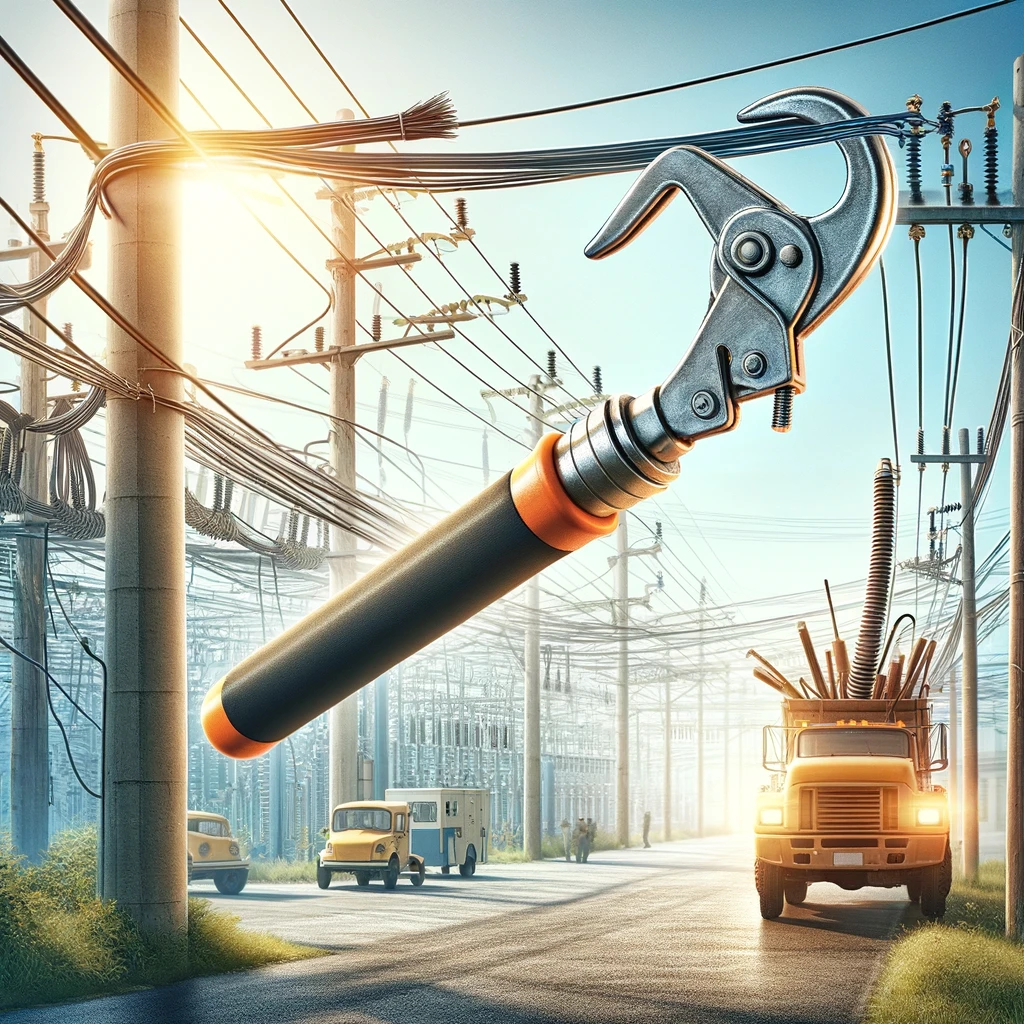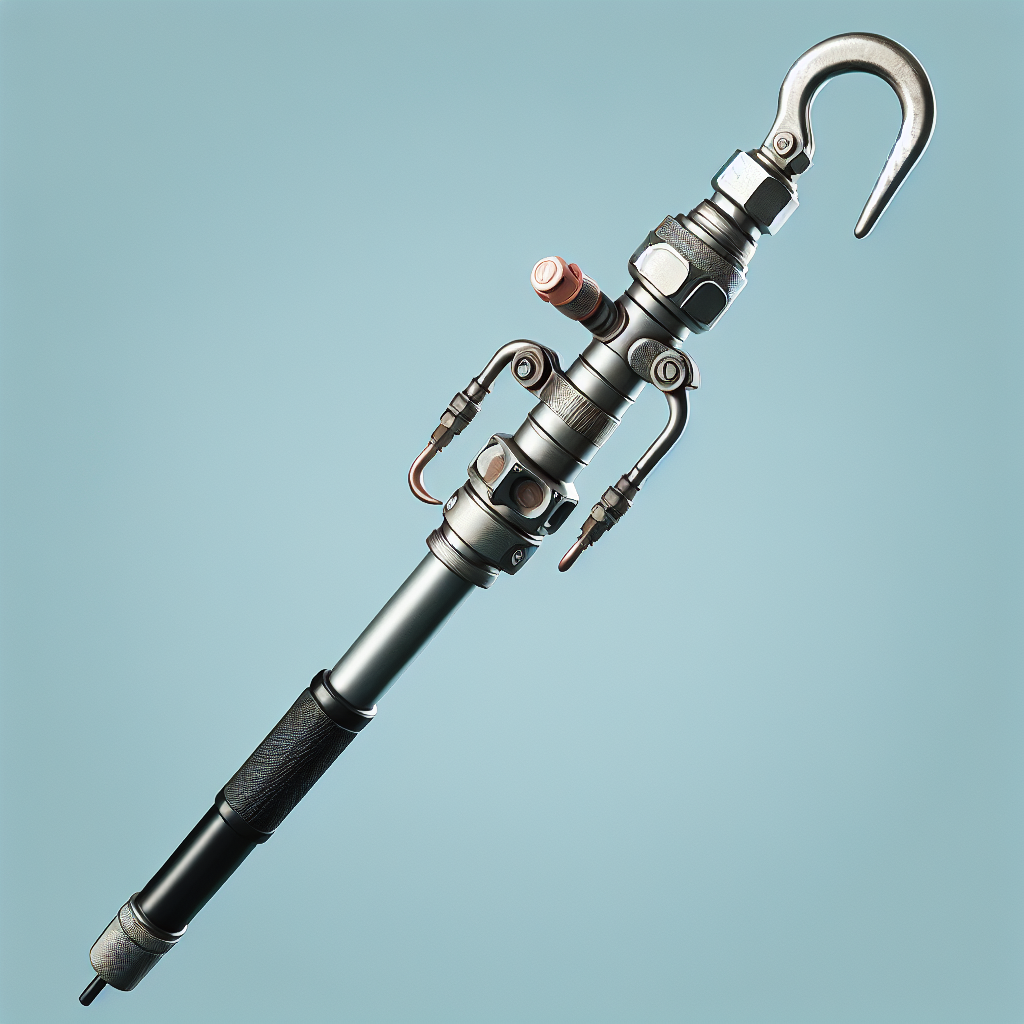Amplifying Safety in Electrical Construction: The Power of the Hookstick
How much do you value safety?
In the field of electrical construction, it cannot be overstated. From voltages capable of delivering lethal shocks to heat from short-circuiting that could lead to fires, electrical hazards are inevitably a part of the job.
But what if there was a tool that could make dealing with these hazards safer? Meet the hookstick.
Whether you’re an electrical veteran or you’re entering the field, it is crucial to familiarize yourself with this handy tool.
Follow us as we explore everything from its basic composition to its critical applications within the industry. Consider this a peek inside the electrician’s toolbox — you might be surprised what you find.

Table of Contents
A Look at the Hookstick in Electrical Work
A Basic Introduction to the Hookstick
At its heart, a hookstick refers to a specific tool used within the realm of electrical construction. Primarily, it is utilized to isolate a piece of electrical equipment. This mechanism operates from a safe distance, hence ensuring the safety of the operator.
What Problem Does a Hookstick Solve?
Safety is the essence of any construction job, especially when dealing with electrical equipment. One key hazard comes from the need to handle electrical devices physically. This is where the hookstick shines, enabling safe disconnection or connection of devices while keeping the operator at a safe distance.
The Assembly and Components of a Hookstick
A hookstick isn’t just a lone object – it’s a culmination of multiple pieces, working together. Let’s take a moment to dissect this tool:
- Insulated pole: The majority of the hookstick is an insulated pole. This section provides the necessary distance between the operator and the electrical equipment.
- The head or the ‘hook’: This part, sitting at the top, does the operational job. It connects or disconnects the electricity devices from safe territory.
- Operating mechanism: Positioned at the user’s end, this trigger-style mechanism controls the device’s ‘hook’ head.
Categories of Hooksticks
Just like many tools in the construction world, there’s not just a one-size-fits-all hookstick. We can categorize them essentially into two types:
- Load Break: This variety can disconnect or connect under load. Such a capability is primarily relevant for overhead line work when there’s a need to remove power but keep the load on.
- No Load Break: As the name suggests, these are for use when there’s no load present on the line. Dealing with no load systems, they can enable safe operation and maintenance.
Hookstick In Action – Practical Applications
Hooksticks serve many uses in electrical construction operations. They’re specifically designed to cover various applications:
Overhead Power Lines
The insulated pole of a hookstick makes it perfect for overhead power lines, where de-energization is often needed. With its extended reach, operators can control the line from the ground, ensuring safety while maintaining system stability.
Switch Disconnection
When it comes to isolating individual switches within an electrical grid, a hookstick is the perfect tool. It provides a safe and efficient way of disconnecting switches, protecting operators from potential electrical surges.
Ring Main Unit (RMU) Operation
For RMUs, which play a fundamental role in electrical distribution networks, hooksticks allow for efficient and safe operation. By utilizing a hookstick, operators can isolate specific sections of the network without interrupting the whole system.
Key Safety Notes for Hookstick Operation
While hooksticks are inherently designed for safety, that doesn’t mean you can ignore best practices. Here are few to keep in mind:
- Only trained personnel should operate a hookstick.
- Ensure the hookstick’s insulated pole is in excellent condition. Any signs of wear or tear could compromise safety.
- Always verify system conditions before hookstick operation. Remember the difference between load break and no load break types!
Think of the hookstick as another important tool in the electrical construction toolkit. When used correctly, it ensures smooth operation of electrical systems while prioritizing the safety of operators and workers.

Exploring Advanced Hookstick Issues
A Closer Look at Hookstick Design
While the basic design of a hookstick includes an insulated pole, a head or hook, and an operating mechanism, advances in technology have led to refined designs. These changes enhance safety features and improve the operational efficiency of the tool.
The Evolution of Hookstick Materials
Early hooksticks were made from wood, which is a natural insulator, but today’s hooksticks are typically crafted from advanced fiberglass or other composite materials. These materials offer superior insulation properties and additional strength, enhancing the overall utility of the tool.
Technology Integration into Hooksticks
In an age of smart tools, hooksticks have not been left behind. Some new designs incorporate sensors and other smart features, such as voltage detectors, into the hookstick design. This allows the operator to confirm the voltage present in the line before they operate it, adding an additional layer of safety.
Potential Drawbacks and Solutions
Despite its indispensable role in electrical construction, a hookstick does have a few potential drawbacks. However, understanding these nuances can help users adequately address them.
Limited Mechanical Force
One of the inherent limitations of a hookstick is the restriction of mechanical force that it can exert due to its design. This makes it less suited for jobs requiring significant force. However, by pairing it with another tool, such as an operating rod with greater mechanical advantage, operators can overcome this limitation.
Condition of the Insulated Pole
The integrity of the insulated pole is crucial to ensure operator safety. Over time, the pole may suffer damage that forms cracks or chips, which can expose the operator to electric shocks. Regularly checking and maintaining the pole, or replacing it when necessary, can effectively address this issue.
Selecting the Right Hookstick
With various hooksticks available in the market, it can be challenging to select the right one for a specific task. Here are a few considerations to guide you:
- Length of the pole: The length should adequately match the task at hand, allowing the operator to handle the equipment without stretching or straining.
- Type of head: Depending on the job, specific head designs may work better than others. For instance, some heads are better fit for overhead lines, while others are ideal for switch operation.
- Features: Some tasks may benefit from hooksticks with additional features, like voltage sensors or advanced grip designs. These can significantly enhance safety and efficiency.
How to Properly Store a Hookstick
Proper storage is crucial to maintain the longevity and performance of a hookstick. After each use, the hookstick should be cleaned, inspected for wear and tear, and then stored in a dry, temperature-controlled environment. Proper storage not only enhances the tool’s lifespan but also its reliability during operation.
Moving Beyond the Basics with Hooksticks
The hookstick’s simplistic design and functionality shouldn’t detract from its complexity and potential. As the tool continues to evolve and integrate with new technology, so too does its capabilities within electrical construction. By understanding its full range of applications, potential drawbacks, and proper maintenance, you can maximize the tool’s potential while ensuring operator safety.
Locating Your Perfect Hookstick
Finding an Electrical Hookstick for Sale
You might now be wondering, “Where can I buy a hookstick?” It all depends on the various factors discussed earlier; the length, the type of hook, and the features you require. Once you’ve decided on your needs, it’s time to hunt for this crucial tool of safety and efficiency.
Browse Online Retailers
Today, several e-commerce platforms offer a broad range of electrical tools, including hooksticks. Prominent platforms include Amazon, eBay, and Alibaba, among others. Make sure you select a reputable seller with positive customer reviews and ratings.
Check Out Local Electrical Stores
If you prefer a hands-on approach to shopping, local hardware or electrical stores are your best bet. Here you can physically assess the hookstick, evaluate its features, and even get a feel of the tool. The advantage here is you can also ask the store’s knowledgeable staff for advice on selection and usage.
Contact Manufacturing Companies
Several companies specialize in the production of Hooksticks. These include well-established companies like Hasting Hot Line Tools and HD Electric Company. Contacting these manufacturers directly can assure you of procuring high-quality, standards-compliant tools.
Considering Second-Hand Hooksticks
Gently-used or second-hand hooksticks can prove a cost-effective option for smaller projects or sporadic use. Consider sites like Craigslist or local resellers. However, be sure to thoroughly inspect the tool for any wear and tear, paying special attention to the condition of the insulated pole, to ensure safety isn’t compromised.
Estimated Pricing for Hooksticks
Pricing for hooksticks varies widely depending on brand, length, features, and whether you’re buying new or used. On average, however, you can expect to pay between $150 and $300 for a new hookstick.
Final Notes on Buying a Hookstick
In the final analysis, purchasing a hookstick is an investment in safety and efficiency. No matter where you decide to buy, prioritizing quality over cost should be your guiding principle. It’s always advisable to read product reviews and potentially even seek advice from industry professionals before making your final choice.
With the right hookstick in hand, you can tackle electrical projects with a higher degree of safety and confidence, driving more successful and streamlined operations.

Hookstick Use and Maintenance
Understanding the Nuances of Hookstick Operation
For a tool that seems relatively simple to use, operating a hookstick does require some technical understanding and skill. Two main factors primarily dictate the correct usage of this tool: the type of electrical equipment in question and the type of hookstick being used.
Operating twist-lock devices with the Hookstick
A common application for hooksticks is interacting with twist-lock devices. These include switches or disconnectors typically found in substations. To operate, the hookstick’s head is inserted into the ring of the twist-lock device, twisted to unlock, then pulled or pushed to open or close the circuit. An important note here is ensuring a firm grip to prevent slippage while turning, which could potentially cause an unsafe situation.
Using Hooksticks with Switchgear
Switchgear refers to devices that control, regulate, and disconnect power systems. The hookstick can safely operate these by hooking onto the device. It’s then pulled or pushed to open or close the circuit. The distance provided by the insulated pole ensures the operator’s safety during this procedure.
Optimizing the Use of Different Types of Hooksticks
As noted earlier, hooksticks come in two primary categories: Load Break and No Load Break. Properly understanding the difference between these two types and where they should be used is essential.
Maximizing the Load Break Hookstick
Load Break Hooksticks are designed for disconnecting or connecting under load. They are most effective in scenarios where power needs to be removed, but the load must remain connected. These are often used in the maintenance of overhead power lines or for emergency grid isolation.
Benefiting from No Load Break Hooksticks
No Load Break Hooksticks are used when there is no load present on the line. Their primary advantage lies in ensuring safe maintenance and operation in no-load conditions. These devices are essential when equipment needs to be disconnected for routine checks and maintenance.
Maintaining the Integrity of Your Hookstick
Just like any other tool, a hookstick requires regular maintenance to ensure its longevity and functionality. Important considerations include:
Inspection Practices for Hookstick
Before and after each use, visually inspect the hookstick for any signs of damage. Look out for cracks, chips, or cuts, especially on the insulated pole. Also, check the operational mechanism and the hook to confirm they are in proper working condition. Regular check-ups can save you from potential electrical accidents.
Repairs and Replacement
Over time, the material of the hookstick, especially the insulated pole, may degrade. If any damage to the insulation is observed, it’s crucial to repair or replace the tool immediately. Similarly, any malfunctioning mechanical parts should be fixed or replaced promptly.
Personal Safety Considerations When Using a Hookstick
The very design of a hookstick caters to safety by putting distance between the operator and the electrical equipment. However, personal protective equipment (PPE) should still be utilized as an added safety measure:
- Gloves: Insulated gloves can offer an extra layer of safety against accidental electrical contact.
- Footwear: Insulated boots can protect against electrical discharge through the ground.
- Eye protection: Debris can sometimes be a consequence of electrical arc flashes. Safety goggles can protect your eyes from such hazards.
While the hookstick is a remarkable tool for safety, it’s always advisable to never rely on the device alone for protection. Adequate training and constant vigilance are equally important when dealing with electrical equipment. After all, safety in the workplace is always a shared responsibility.
Wrapping It Up
In undertaking complex tasks within the realm of electrical construction, the hookstick emerges as a mainstay tool, becoming indispensable in ensuring the safety of operators.
By facilitating safe disconnection or connection of electrical equipment from a distance, it negates the need for direct physical engagement with potentially hazardous components.
Whether dealing with overhead power lines or carrying out operations on Ring Main Units, this device proves its worth over and over.
Remember, however, that safety never stops at the tool; we must abide by good operational practices too. So, while a hookstick can do a lot for worker safety, it goes hand-in-hand with operator proficiency and care.
The need for trained personnel to operate a hookstick, maintain its insulated pole in excellent condition, and understand the system conditions before operation cannot be overemphasized. The hookstick, in essence, exemplifies how sophisticated tools coupled with vital safety protocols can elevate the efficiency and safety of electrical construction tasks.






